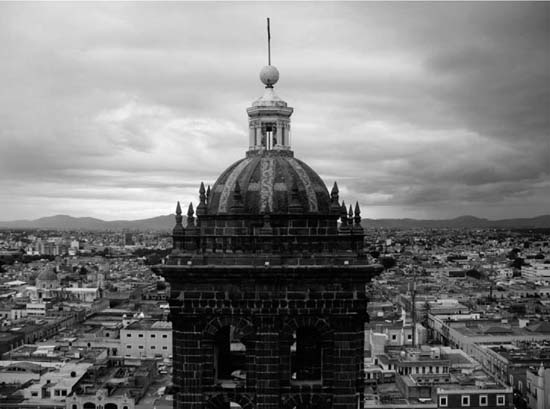
You hear a lot about Mexico in the news, and unfortunately much of it is downright scary. As of this writing, the drug wars in the border state of Chihuahua raged unchecked despite a massive effort by the government to crack down on the cartels. Traveling to certain parts of the country these days is not merely inadvisable, but practically asking for trouble. Then there’s the N1H1 flu, which originated in Mexico in 2009 and became a global pandemic.
None of these are trivial issues, and travelers should take every precaution when visiting Mexico. But I mention the bad before the good only because a negative news update can sometimes shine a frightening spotlight, when the reality is far less intimidating. Is Mexico still in the grip of a deadly disease? Fortunately, by summer 2009 the swine flu pandemic was largely under control and Mexico City had returned to normal. New flu cases were still being reported, and some officials and residents continued to wear the surgical masks that were ubiquitous in the initial stages of the outbreak, but the near-total shutdown of the city is a thing of the past. Many countries have lifted their travel bans to Mexico, and there is a concerted effort under way to galvanize the country’s tourism industry. Tourists planning a trip to Mexico City should check the World Health Organization’s updates (www.who.int/csr/en/) as well as the advisories posted by the U.S. Centers for Disease Control and Prevention (CDC) (wwwn.cdc.gov/travel/content/novel-h1n1-flu.aspx).
No matter where you go in Mexico, you need to travel smart; there are ways for tourists to safeguard against crime, sickness, and even getting ripped off (although this will be, to some extent, unavoidable). Visitors can take steps to ensure their experience in Mexico is positive and rewarding. That’s what this chapter is all about.
All travelers to Mexico are required to present original photo identification and proof of citizenship. All U.S. travelers to Mexico are required to present a valid passport at the airport and upon reentry to the United States. If you have a foreign passport but are a legal resident of the U.S., bring your green card as well. Always treat these documents as your most precious commodities when traveling abroad. In case you lose your passport, contact your country’s embassy or consulate immediately.
Citizens (and legal residents) of the U.S., Canada, and several other countries around the world do not need a visa to enter Mexico but are required to have a Mexican Tourist Permit (FMT), which serves the same purpose. If you are flying to Mexico, your airline should provide you with this absolutely critical document, but in case you don’t get one on board, it is available upon arrival at the airport. The FMT card can be issued for up to 180 days, and will be given a stamped time limit by immigration officials. Often, officials will arbitrarily assign an exit date, so if you are planning to stay a long time (say, more than 60 days), make sure to ask for the full time limit. Just say, “Ciento ochenta días por favor” (180 days, please). After the FMT card is stamped, it will be handed back to you. Do not discard it! Visitors are required to present the card upon exiting Mexico. Failure to produce it will result in fines and bureaucratic hurdle-jumping that will have you cursing the country before you leave. Just ask my mother.
After immigration, you will pass through customs. You must have a completed Customs Declaration Form; air travelers will receive this document too from the airline. You will then punch a button to find out if you have a green light (cleared to proceed) or a red light (need to have your luggage checked). It is truly arbitrary.
Customs officials are lenient when it comes to what you can bring into Mexico duty-free. Technically, the list is quite specific: no more than two cameras, five toys, three speedboats . . . it goes on. In practice, however, officials are mainly concerned with people trying to bring in items for resale. Obviously, drugs and firearms are not allowed. Tourists traveling by air are allowed to bring in gifts and permitted goods up to a value of $300 (by land, the amount is $50, except for alcohol and tobacco). If you exceed this amount, you have to pay a flat 15 percent tax on the amount exceeding the exemption. You can also bring in a computer with peripherals worth up to $4,000 duty-free, but you will be required to hire a customs broker if its value exceeds this amount. If you are carrying in excess of $10,000, you must declare it on the customs form but you won’t be required to pay tax on it. For the latest customs information in English, visit www.aduanas.sat.gob.mx/aduana_mexico/2008/pasajeros/139_10134.
html, or call 800-463-6728 toll-free in Mexico.
Embassies in Mexico City
Canada
55-5724-7900
www.canadainternational.gc.ca/mexico-mexique/index.aspx
Schiller 529, Col. Bosque de Chapultepec, Mexico, D.F.
United Kingdom
55-5207-2449
Río Lerma 71, Col. Cuauhtémoc, Mexico, D.F.
United States
55-5080-2000
Paseo de la Reforma 305, Col. Cuauhtémoc, Mexico, D.F. (Mexico address)
American Embassy Mexico, P.O. Box 9000, Brownsville, TX 78520-9000 (U.S. address)
When leaving Mexico, U.S. citizens who have been in the country for at least 48 hours can take back $800 worth of goods duty-free. (Note that close to 3,000 items, including all Mexican handicrafts, are exempt from U.S. customs duties.) There is a flat rate of duty on anything above this amount. Lottery tickets, drugs, fireworks, and many food products are among the items that cannot be brought back into the U.S. from Mexico. Also on the list are Cuban cigars, which are available in the country (although not all “Cubans” sold in Mexico are really Cuban). For the full list of what is permissible and duty fees, visit the U.S. Customs and Border Protection Web site at www.cbp.gov, or call 877-287-8667.
Central Mexico, which includes Mexico City, Puebla, and Cuernavaca, is an elevated, mountainous region that enjoys pleasant weather for most of the year. There is a rainy season, which runs from April to October, although Cuernavaca has a more subtropical environment. Rain is sporadic, and many times of the flash-flood variety: strong downpours that appear suddenly and vanish after a short but thorough soaking. The rainy season also overlaps with the hottest months of the year in April and May. The dry season runs from mid-October to April, and includes a mild winter from December to February, when it’s brisk enough to require warm clothes but is certainly not extreme. Mexico has a hurricane season in the fall, but while storms and rough winds might batter the coasts, the most you’ll experience in central Mexico is overcast days and strong rains, with occasional flooding.

Overcast skies are common during the rainy season
Altitude plays a major role in influencing the weather. Mexico City is at an elevation of over 7,000 feet above sea level, and most of the rest of the central region is above 5,000 feet. Throughout the year, the higher areas like Mexico City can see any number of cool nights, but this makes for a pleasant contrast to the very agreeable weather during the day.
So when should you go, and what should you pack? Mexico has two travel seasons. High season runs from December to the end of March, and low season from April to December. However, while the coastal resort towns have seasonal fluctuations in prices depending on the time of year, don’t expect these variations in central Mexico. Also, there are spikes in travel during major holidays, especially Easter and Christmas. Personally, I love traveling to this part of the country during the winter months, when the weather is perfect during the day and cold but not unbearable at night, and when some of Mexico’s best annual festivals take place.
Regardless of when you go, check the weather forecast beforehand. It’s not uncommon for travelers to walk around in a T-shirt and jeans during the day and change into a nice pair of trousers and a warm sweater for evening. Part of this is owing to the weather and part to style. Mexicans dress well and conform to a certain standard when stepping out at night. At most restaurants, the shorts-and-Hawaiian-shirt getup will have you sticking out like the worst kind of gringo. In fact, it’s rare to see Mexico City men and women wearing shorts, even on the hottest days.
While I recommend variety when it comes to your suitcase, my other piece of advice is to leave the valuables at home. It’s no secret that there is crime in Mexico City (although it is less prevalent in Puebla and Cuernavaca), and wearing flashy jewelry isn’t the wisest move when you’re out on the town.
For the purposes of this book, your entry point into Mexico will most likely be the well-appointed Benito Juárez International Airport in Mexico City, although some international carriers fly to Puebla as well. There is also excellent bus service from the airport directly to Cuernavaca and Puebla.
As of this printing, the airport has recently opened a new terminal, which is still being filled with the requisite gift shops, restaurants, and other services. Terminal One has plenty of places to shop and eat, as well as all the major services for tourists. Both terminals are linked by a monorail, and international flights arrive at either one, depending on the airline. The monorail can be useful especially for travelers coming into the newer terminal. Sometimes there are no taxis waiting here, while a short hop on the free monorail will take you to Terminal One, where a long line of taxis stands ready. The airport has an excellent bilingual Web site (www.aicm.com.mx), or you can call 55-2482-2424 or 2482-2400 for information.
Of course, you can also travel to Mexico by car, but I would advise against it. For one, you’ll have to go through the Mexico-U.S. border, which can be a nightmare, especially on the return trip. For another, it’s a lengthy drive from the border to central Mexico, and while driving is a great way to see the country, taking a car into Mexico is only advisable for those who are planning a long stay.
Virtually every major American and international carrier flies into Mexico through Benito Juárez International Airport. In addition, a host of regional and national airlines operate here. Here is just a sample of the major foreign carriers serving the airport from U.S. cities, as well as Mexican airlines with international routes. As with any international flight, make sure to arrive at your departure airport at least two hours prior to the flight time.
AeroMexico
800-237-6639 (U.S.)
55-5133-4000 (Mexico City)
800-021-4000 (toll-free in Mexico)
A member of the Sky Team alliance, AeroMexico serves more than 40 destinations around Mexico and has direct flights to seven U.S. cities.
Aviacsa
866-246-0961 (U.S.)
55-5482-8280 (Mexico City)
800-AVIACSA (toll-free in Mexico)
Primarily a local airline, Aviacsa has one cross-border route to Las Vegas.
Mexicana
800-531-7921 (U.S.)
55-5998-5998 (Mexico City)
800-801-2010 (toll free in Mexico)
The airline with the fourth-longest tradition in the world, Mexicana also has the most extensive international coverage from Mexico.
Alaska Airlines
800-252-7522 (U.S.)
American Airlines
800-433-7300 (U.S)
55-5209-1400 (Mexico City)
800-904-6000 (toll-free in Mexico)
Continental Airlines
800-523-3273 (U.S.)
55-5283-5500 (Mexico City)
800-900-5000 (toll-free in Mexico)
Continental flies to Mexico City and also has direct flights to Aeropuerto Internacional de Puebla.
800-221-1212 (U.S.)
55-5279-0909 (Mexico City)
800-123-4710 (toll-free in Mexico)
Northwest Airlines/KLM
800-225-2525 (U.S.)
55-5279-5390 (Mexico City)
800-907-4700 (toll-free in Mexico)
Northwest flies into Mexico City and Puebla.
United Airlines
800-864-8331 (U.S.)
55-5627-0222 (Mexico City)
800-003-0777 (toll-free in Mexico)
US Airways
800-428-4322 (U.S.)
Air Canada
888-247-2262 (U.S. and Canada)
55-5208-1883 (Mexico City)
Air France
800-992-3932 (U.S.)
55-5627-6060 (Mexico City)
British Airways
800-247-9297 (U.S.)
866-835-4133 (toll-free in Mexico)
Iberia
800-772-4642 (U.S.)
55-1101-1515 (Mexico)
Japan Air Lines
800-525-3663 (U.S.)
55-5242-0150 (Mexico)
800-399-5838 (U.S.)
55-5230-0000 (Mexico)
Qantas
800-227-4500 (U.S.)
800-892-9761 (toll-free in Mexico)
Taca
800-400-TACA (U.S.)
55-5553-3366 (Mexico City)
800-400-8222 (toll-free in Mexico)
Again, I urge tourists not to travel by car from outside the country to Mexico City, Puebla, or Cuernavaca unless they are coming here for a long stay and plan to tour the country extensively. Why am I so adamant? Let’s start with the paperwork. At the border checkpoint, travelers are required to present the original and two copies of the following documents:
• Valid proof of citizenship (passport or birth certificate).
• The Mexican Tourist Permit (FMT).
• A valid vehicle-registration certificate, or a document, like the vehicle’s title, that certifies legal ownership by the driver.
• A leasing contract, if the vehicle is leased or rented, in the name of the renter. If the vehicle belongs to a company, you must have documentation that certifies your employment with that company.
• A valid driver’s license.
• An international credit card in the name of the driver of the vehicle.
Drivers also need a temporary car-importation permit. To acquire this, you have to bring all these documents to the customs office at the border. Go through the Declarations Lane and look for the MODULO DE CONTROL VEHICULAR sign. You’ll be in for a much easier time if you have a credit card, which you can use to post the required “return guarantee” bond. If you don’t have a credit card, you’ll have to leave a guarantee deposit based on the model year of the vehicle. In Texas, California, and Illinois, drivers can arrange for the certificate and payments in advance from the Mexican consulate. Note: The owner of the car or a relative must be in the car at all times while it’s being driven in Mexico. Drivers must also get their vehicle insured in Mexico, as liability insurance is mandatory and U.S. coverage is invalid. U.S. companies that provide insurance in Mexico are located at the border.
Then there is the driving time, which can vary from 12 to 48 hours from the border. For example, the drive from the border city of Juárez to Mexico City will take you roughly 23 hours. From Tijuana to Mexico, it’s about 33 hours. And that’s not counting how long it will take you to get from your point of departure to the border. And finally, there is the simple fact that rentals are readily available once you get to Mexico, and bus travel within the country is excellent.
Rental Car
If you want to rent a car after arriving in Mexico, the following car-rental agencies are available in the international section of Mexico City’s airport, in Concourse E.
Alamo
55-5786-9214
Open 24/7
Avis
55-5786-9452
Open 24/7 except Monday
Budget
55-5762-0900
Open daily 7 AM–11 PM
Economóvil Rent
55-2599-0148
Open Monday to Friday 8 AM–10 PM, Saturday 8 AM–6 PM
Europcar
55-5786-8265
Open 24/7
Gold Car Rental
55-2599-0090
Open 24/7
Hertz
55-5762-8977, 5784-7400, 5784-7628
Open daily 7 AM–10:30 PM
Kim Car Rent
55-2599-0267
Open daily 7 AM–11 PM
Royal Rent-a-Car
55-5802-8000, 5802-8398
Open daily 7 AM–10 PM
Thrifty
55-5786-9486, 5786-9487, 5786-8268
Open daily 7 AM–11 PM
Surprisingly, there is no bus service from the airport to Mexico City; unless you rent a car, you will have to rely on the metro or take a taxi. However, there is convenient and comfortable bus service directly from the terminal to Cuernavaca and Puebla.
Autobuses Estrella Roja
55-5786-9341, 5786-9358, 5786-9338, 5786-9342
Ground Terminal, International Section
Service runs 24 hours a day, bound for Puebla. $$.
Autobuses Pullman de Morelos
55-5786-9341, 5786-9358, 5786-9338, 5786-9342
Ground Terminal, International Section
Service runs 24 hours a day, bound for Cuernavaca. $$.
The Terminal Area Station on Line 5 takes you into the city. It is open Monday to Friday 5 AM–1 AM, Saturday 6 AM–midnight, Sunday 7 AM–10 PM. It’s a bit of a hassle, but by far the cheapest way to travel. $.
Taxis are the most convenient way to get to Mexico City. Travelers should use only authorized airport taxis, available directly from the terminal. Follow the GROUND TRANSPORTATION signs to the end of the terminal, where you’ll see taxi counters. Buy your ticket at the window (make sure to request a regular sedan; the large vans are more expensive). The rates are based on zones, which are displayed at the counter. You can take a taxi from the airport directly to Cuernavaca or Puebla, but this will be significantly more expensive than the bus.
Protaxi Ejecutivo
55-2599-0333
Operates 24/7. $$–$$$.
Sitio Taxi
55-2482-2424, 55-5571-9344
Operates 24/7. $$–$$$.
Negative preconceptions of Mexico travel abound, fueled by horror stories about near-death illnesses after consuming the local food, ripoffs everywhere, kidnappings, and worse. Unfortunately, these stories often have more than a grain of truth to them. At the same time, a little bit of common sense will enable you to avoid many of the pitfalls that snare the less-savvy tourist.
Safety is a major concern for most Americans traveling to Mexico. I don’t think I’ve ever said “I’m going to Mexico” without getting a raised eyebrow or a “Be careful!” But the basic fact is that millions of U.S. citizens visit Mexico every year without incident. For every horror story, there are many more tales of wonderful vacations.
It goes without saying that tourists should always exercise caution in any foreign country. The most frequent incidents in Mexico City are mugging, armed robbery, and kidnapping. A common practice with respect to the latter involves taxis, especially green-and-white Volkswagen Beetles. The way the scam works is as follows: a taxi picks up an unsuspecting passenger and follows a predetermined route. At a prearranged intersection, armed individuals jump in the cab and mug or kidnap the victim. For this reason, it cannot be stressed enough that while in Mexico tourists rely on sitio or radio taxis (these are taxis located at designated taxi stands; alternatively, a pickup can be arranged over the phone).
If you are the victim of a robbery or mugging, don’t resist. But you can also lessen your chances of being targeted by not wearing valuables, and limiting the cash and credit cards you carry. A basic rule of traveling abroad is to lock your extra cash, valuables, and passport in a hotel safe. Here are a few other simple precautions to follow while in Mexico:
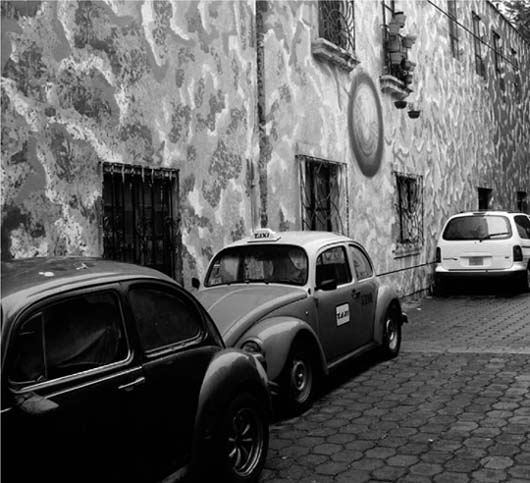
For safety’s sake, avoid the free-ranging green-and-white VW Beetle taxis
• When driving, use main roads whenever possible; when driving longer distances, especially at night, use toll roads.
• If possible, carry a cell phone with international coverage. If you don’t have one of these, buy a phone card, which are widely available.
• Remember three numbers:
060 for reporting crime
065 for the Red Cross and ambulance service
078 for tourist assistance
• Try to stay in well-lit areas at night, and keep to secure neighborhoods.
• At night, take a sitio taxi to and from your destination.
• Always keep the phone number and address of your hotel handy. Many hotel key-cards have this information printed on them.
• Before your trip, check the latest U.S. State Department travel advisories for Mexico at www.travel.state.gov.
“Montezuma’s Revenge” is the popular term among foreigners for the potent and unpleasant causes of consuming unhygienic food or drinking unclean water. The Mexicans call it turista. The symptoms include nausea, diarrhea, stomach cramps, and fever. If your condition is severe, visit a doctor.
Can you avoid it? Yes and no. Some tourists, especially those traveling abroad for the first time, will have an adverse reaction to foreign foods. It’s impossible to predict exactly how your digestive system will respond, but there are ways to keep Montezuma’s vengeful spirit at bay. The easiest and most important is to never drink tap water. Many hotels and restaurants serve purified water, but to play it safe, always order bottled water.
Also, take your gastronomic tour of Mexico in gradual steps. Heading from the airport directly to the nearest taco stand isn’t the wisest move if this is your first trip. Try to avoid spices and raw vegetables until you’re completely acclimated. Practically every restaurant in Mexico has fresh limes on the table for seasoning. Make liberal use of these, which can help keep you healthy. Your body has to adjust to its new environment, and that includes adjusting to new foods. It takes time, but even if Montezuma wags his finger in your direction, leaving your stomach a little unsettled, I’d encourage you to persevere. Mexican food is worth the initial trouble.
For the purposes of this book, we’ll discuss pollution as strictly a Mexico City issue—the air in Cuernavaca and Puebla is fine. So how bad is it in the capital? The truth is that Mexico City’s air had long been considered very clean. In the last few decades, however, pollution became a serious problem, so much so that it was a health risk for animals as well as people.
The good news is that things have gotten better. Sure, there is still a layer of smog to contend with, and pollution limits often exceed acceptable levels as measured by Mexico’s Metropolitan Index of Air Quality (IMECA). But the city is in the midst of an ambitious environmental cleanup program targeting air quality and emissions. I wouldn’t embark on a five-mile jog the day after I land in Mexico, but that has as much to do with the altitude as with the air quality. If you want to know how clean the air is on any given day, check the Web site of the Atmospheric Monitoring System of the City of Mexico at www.sma.df.gob.mx/simat/. The IMECA scale is as follows:
• 51–100: Regular
• 101–150: Bad
• 151–200: Very Bad
• Over 201: Extremely Bad
As long as the numbers fall between 0 and 150, the vast majority of people—locals and tourists alike—need not worry. As you can imagine, numbers over 150 do not signal good levels of air quality, and if the levels push beyond 201, the city is likely to take action.
As for altitude, most of central Mexico is at an elevation of above 5,000 feet. Altitude sickness affects some travelers more than others. Many people won’t notice much of a change; some may find the air a little thin; still others might experience headaches, dizziness, shortness of breath, and fatigue. Travelers with heart- or lung-related medical problems should consult with a doctor before flying to Mexico City. If you do experience any of the above symptoms, do not exercise, drink plenty of fluids but stay away from alcohol, and wait it out. As with the food, your body will adjust.
Over drinks one night, a Mexican friend of mine turned to me and asked, “What do you think of us?” The question wasn’t directed at me specifically, but rather at Americans in general. Many Mexicans have something of a complex when it comes to their gringo neighbors, and it’s not surprising why. Mexicans are well aware that the sentiment across the border isn’t always positive. Whether it’s because of illegal immigration, crime, or a general misconception, the people of this country have long been viewed in a negative light by their neighbors to the north.
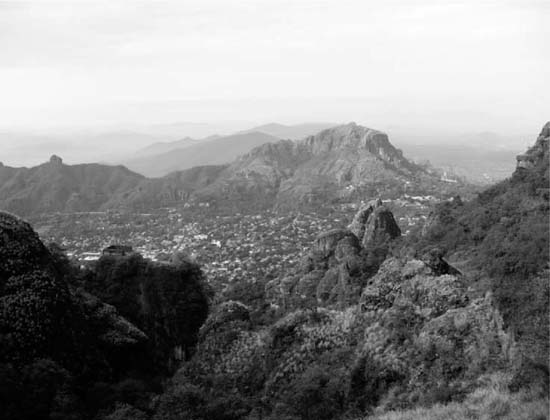
Like Tepoztlán, south of Mexico City, most of central Mexico is at an altitude above 5,000 feet
The Basílica de Guadalupe in Mexico City is Mexico’s holiest shrine Credit: Mexico Tourism Board
Anyone who visits Mexico City with these prejudices will not just be pleasantly surprised, but quite possibly stunned. I have to admit, the first time I came here, it happened to me. I never expected an urban center of such sophistication, culture, and elegance. And I was moved by the kindness that so many strangers showed me. Once people understand that you don’t think negatively of them and their country, they will open up to you, and you’ll find them to be friendly and helpful. But if you’re condescending, expect no warmth in return.
Family is very important in Mexico, but so is friendship. Expect a Mexican man to defend his friend at all costs in any bar spat, no matter who’s at fault. You’ll also find Mexicans to be generally very polite. Men are addressed as señor, women as señora, and young women or girls as señorita. Another common prefix you’ll hear is licensiado/a, a title of respect referring to college graduates.
Mexicans love their food and drink—the latter a bit too much, sometimes. They also love their heritage, both the colonial and the indigenous side of it; Mexican people have a strong identity and are proud of their nation’s role as an intellectual and artistic center in Latin America. And they especially love the Virgin Mary. Mexico is the largest Roman Catholic nation in the world after Brazil, a remarkable testament to the Spanish missionaries who came here at the dawn of the New World. About 90 percent of the population is Catholic, and la Virgen, in her many forms, is the most revered figure in Mexico. There are hundreds of representations of the virgin, but the most beloved is la Virgen de Guadalupe (the Virgin of Guadalupe). More than a religious icon, she is a national symbol.
The currency of Mexico is the peso. It is indicated by the $ symbol and the code MXN. As of this printing, $1 USD was the equivalent of about $13 MXN. While there are some businesses that will take payment in dollars, expect to pay in pesos everywhere you go.
Changing money is easy and convenient in Mexico. Banks and/or casas de cambio (money-changing booths) are usually a short walk away. If the line at the bank is long (always the case on Fridays), casas de cambio are almost always quick and they’re open later than banks. Cash in Spanish is known as efectivo. When it comes to your efectivo, a useful tip is to horde your change. Buses, taxis, and taquerías all crave or require it, and you’ll need plenty for tips.
Credit cards are widely accepted, Mastercard and Visa more than American Express. Cards are called tarjetas de crédito. Some establishments will add a small surcharge (3 to 6 percent) to your bill if you’re paying by card. Your local bank ATM will not work here (international ATMs do), but if you’re in a pinch, a bank will issue a cash advance on a credit card account.
Determining a budget is a tough thing to do in Mexico, because your expenses can range from minimal to exorbitant. The good news is, you can tailor your vacation to just about any budget you set . . . even if it means a steady diet of street food (not a terrible way to go).
A 10 percent tip is customary and expected at restaurants and hotels, and at the end of organized tours, but not at taco stands, inexpensive eateries, or for taxis. Still, a tip is always appreciated. A 15 percent value-added tax, known as impuesto al valor agregado (IVA) is added to all goods and services purchased in Mexico. Hotels add an additional 2 percent lodging tax.
Mexican food has been as misrepresented as the land it comes from. The tacos, burritos, and enchiladas so widely available throughout the U.S. can scarcely be found once you cross the border . . . at least, not in the way they are presented stateside. But the cuisine here goes much further than the street food we know and love. Its roots span millennia and incorporate ingredients, recipes, and techniques from the Aztecs, the Spanish, the French, and the U.S. (when McDonald’s first opened in Mexico City, there was a line around the block to get in).
The pre-Hispanic tribes are responsible for the nation’s most essential foods—tortillas and tamales, for example—as well as some of its most flavorful ingredients. Some are well known to us, like cocoa, corn, and chile; others are more exotic, and include a great variety of flora. Flor de calabaza (squash blossom), nopales (the fleshy pads of the cactus), and cuitlacoche (a truffle-like fungus found on corn) are three staples of classic Mexican cooking.
The Spanish brought other essentials, including beef, pork, rice, garlic, and oil. Their influence, along with later contributions by other cultures (including African, Asian, and other European nations), greatly expanded Mexican gastronomy. This diverse legacy has produced a broad range of cuisine, from strips of meat slapped together between a tortilla to refined dishes that use techniques and flavors subtle enough to please the most discriminating gourmand.
Sampling all of these flavors and delicacies is one of the joys of traveling to Mexico, but to really savor the experience, be a bit adventurous. Some of the delicacies available to you will range from eyebrow-raising to run-for-the-door. I always take a bring-it-on attitude with me to any eatery in Mexico, and for the most part, it has served me well. Then there’s the language. Even if you know Spanish, you’ll be dumbfounded by many items on the menu, either because they are in Nahautl or because they use unfamiliar Mexicanisms.
To help you navigate through this new culinary world, I’ve included a Traveler’s Dictionary that includes popular Mexican ingredients and foods at the end of this book. But don’t let the drawbacks of language and exotic ingredients deter you from branching out where your palate is concerned. Even if you’re not the adventurous type, you can’t leave Mexico without visiting at least one taquería. I believe it’s in the constitution. Or at least, it should be.
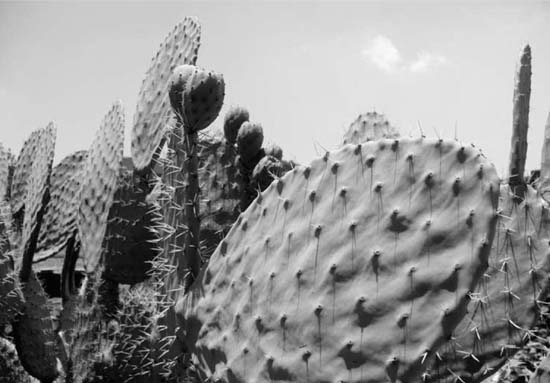
Nopales from cacti are a popular food all over Mexico
As for what to drink, alcohol goes back to the pre-Columbian tribes, but they went about things a little differently. The Aztecs only allowed the priest class and the elderly to drink; everyone else faced capital punishment for imbibing. Modern Mexicans have both more variety in their spirits and more lenient rules. The locals love their cerveza, or beer, which is available just about everywhere. Then there’s a smorgasbord of local liquor, starting with the world-famous tequila, which has been around for over 400 years, and of which there are over 700 brands. Tequila is made from the blue agave plant and is generally found in two categories: 100 percent blue agave and tequila mixto (mixed). Within these categories, there are finer distinctions:
• tequila blanco (white tequila). The purest form of the blue agave, this spirit is clear and unaged.
• tequila joven abocado (young, smooth tequila). A gold-colored, young, and relatively inexpensive formulation.
• tequila reposado (“rested” tequila). A popular golden variety aged between two and 11 months.
• tequila añejo (aged tequila). A refined, rich, and smooth spirit that must be aged for at least one year.
• tequila extra añejo (extra-aged tequila). A classification given to tequilas aged more than three years, this variety has a darker hue than regular añejo.
After tequila comes a parade of Mexican liquors. Mezcal is a cousin of tequila, a strong liquor made from different types of maguey plants. Pulque, the fermented sap of the agave plant, has a nutty flavor; the best place to enjoy it, both for variety and local ambience, is at a pulquería. Pasita is a liquor made from raisins. And aguardiente, which is typically made from sugarcane, begins at around 75 proof. It’s not called firewater for nothing. There are also several other regional brews.
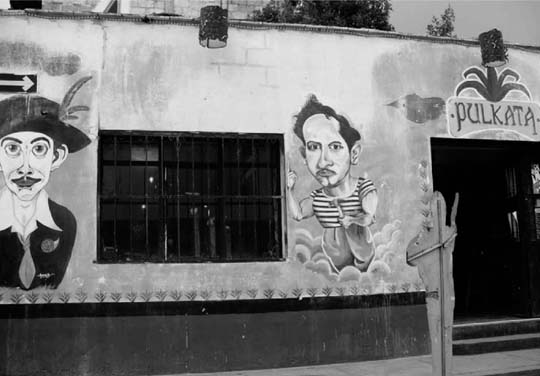
Pulkata, in Cholula, is a classic pulquería
Finally, a host of other alcoholic beverages are popular here: brandy, Kahlua, Cointreau, wine (specified as vino de uva, or grape wine), and a variety of mixed drinks and cocktails. The most famous of these, of course, is the margarita.
The last thing on your checklist is when to go. This is not merely a weather-based decision; it also depends on what’s going on in Mexico throughout the year. Because there are literally thousands of festivals, parades, and parties in the country, I’ve focused on the biggest and the most beloved national events, or those specific to Mexico City, Puebla, and Cuernavaca.
January 1: New Year’s Day. Año Nuevo is a national holiday, a day when many a hangover is nursed back to health.
January 6: Three Kings Day. Día de Los Reyes marks the end of the Christmas season. It is the most important day of the season, when gifts are traditionally exchanged and families eat a special cake called rosca de reyes (“kings’ wreath”), a large doughnut-shaped fruitcake into which is baked a small figure of a baby. The person who gets the slice with the baby has the responsibility of throwing a party on (or before) Candlemas, or Candelaria.
February 2: Candlemas. Día de Candelaria is a nationwide celebration marking the end of winter and honoring the rebirth and fertility of the land.
February 5: Constitution Day. Día de la Constitución is a national holiday commemorating the ratification of the Mexican constitution in 1917.
February: Carnaval. The exact date of Carnaval varies, but it takes place during the week leading up to Lent and involves all the color, noise, and pageantry of Mardi Gras.
February 24: Flag Day. On this nationwide holiday, public figures outdo one another in their efforts to proclaim their patriotism.
March 21: Benito Juárez’s Birthday. A national holiday to honor one of Mexico’s most revered leaders.
March/April: Easter. Semana Santa (Holy Week) is the most popular religious celebration in Mexico, marked by pilgrimages, huge masses, and parades.
May 1: Labor Day. A national holiday, called Día del Trabajo.
May 5: Cinco de Mayo. Mayo 5 is celebrated around the U.S. as a time to get drunk. Most people don’t know that the holiday marks a historic battle between French and Mexican troops in Puebla.
May 10: Mother’s Day. As mentioned, the maternal figure has long been sacred in Mexico. It’s little surprise, then, that Día de la Madre, or Mother’s Day, is given serious attention here.
September 1: Presidential “State of the Nation.” A great time to be in Mexico City’s Zócalo, or central square, to hear the president wax poetic . . . or passionate . . . or loquacious.
September 15–16: Independence Day. Celebrated in every nook and cranny of Mexico, these two days honor the end of Spanish rule in Mexico. Millions cram into Mexico City’s Zócalo to hear the president give el grito (the cry), echoing Miguel Hidalgo’s proclamation of independence in 1810.
November 1–2: Day of the Dead. Día de los Muertos is my favorite holiday in Mexico. All Saints’ Day is November 1, while the official Day of the Dead is November 2. Skeleton costumes abound, parades are held, and thousands of people throw open their homes to strangers bearing offerings for the dead.
November 20: Revolution Day. Día de la Revolución is another national holiday where politicians take center stage and launch patriotic speeches.
December 12: Feast of the Virgin of Guadalupe. One of the most important religious holidays in the country, December 12 brings an annual horde of people to la Virgen’s shrine in Mexico City.
December 16: Beginning of the Christmas season. The Christmas season stretches from December 16 to January 6, and includes parades, processions, and parties. Beginning December 16 there are nine days of posadas—candlelight processions that travel to a community’s nativity scene or a neighbor’s home, reenacting Joseph and Mary’s search for lodging.
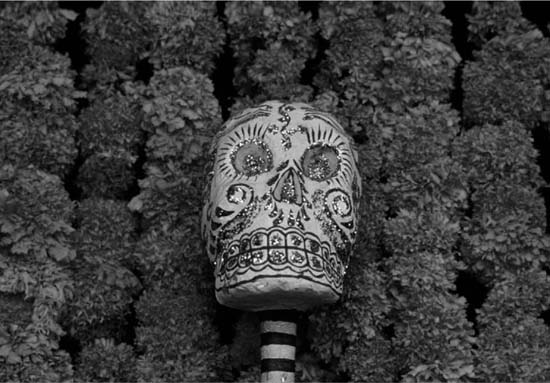
Day of the Dead decoration Credit: Mexico Tourism Board
December 24–25: Christmas Eve and Christmas Day. On Christmas Eve (Nochebuena) a midnight mass called Misa del Gallo, or Rooster’s Mass, is held, with masses continuing throughout Christmas Day.
December 28: Day of the Innocents. Día de los Inocentes is Mexico’s April Fool’s Day.
December 31: New Year’s Eve. A night of revelry and partying, to close the chapter on the old and welcome the new. In Mexico it’s called Nochevieja, or Old Night.
Mexico City today